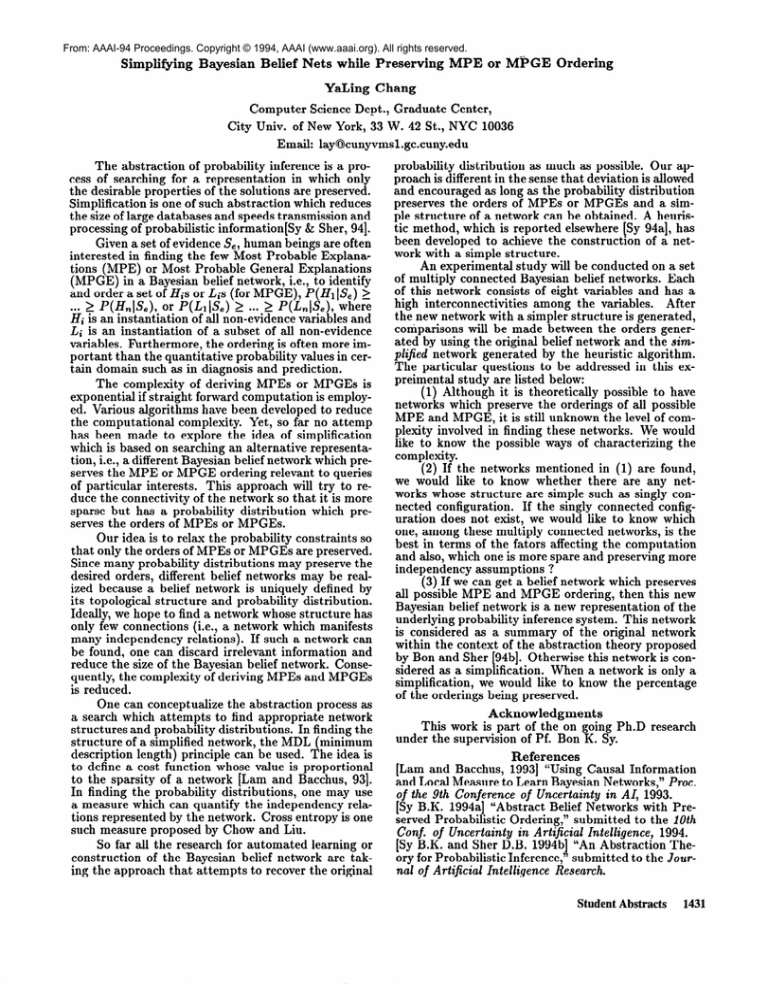
From: AAAI-94 Proceedings. Copyright © 1994, AAAI (www.aaai.org). All rights reserved.
Simplifying Bayesian Belief Nets while Preserving MPE or M-i>GE Ordering
YaLing Chang
Computer Science Dept., Graduate Center,
City Univ. of New York, 33 W. 42 St., NYC 10036
Email: lay@cunyvmsl.gc.cuny.edu
The abstraction of probability inference is a process of searching for a representation in which only
the desirable properties of the solutions are preserved.
Simplification is one of such abstraction which reduces
the size of large databases and speeds transmission and
processing of probabilistic information[Sy & Sher, 941.
Given a set of evidence S,, human beings are often
interested in finding the few Most Probable Explanations (MPE) or Most Probable General Explanations
(MPGE) in a Bayesian belief network, i.e., to identify
and order a set of His or Lis (for MPGE), P(Hr]S,) 2
2 . .. 2 P(Ln]Se), where
.. . > P(HnlSe), or P(Li]$)
Hi z an instantiation of all non-evidence variables and
Li is an instantiation of a subset of all non-evidence
variables. Furthermore, the ordering is often more important than the quantitative probability values in certain domain such as in diagnosis and prediction.
The complexity of deriving MPEs or MPGEs is
exponential if straight forward computation is employed. Various algorithms have been developed to reduce
the computational complexity. Yet, so far no attemp
has been made to explore the idea of simplification
which is based on searching an alternative representation, i.e., a different Bayesian belief network which preserves the MPE or MPGE ordering relevant to queries
of particular interests. This approach will try to reduce the connectivity of the network so that it is more
sparse but has a probability distribution which preserves the orders of MPEs or MPGEs.
Our idea is to relax the probability constraints so
that only the orders of MPEs or MPGEs are preserved.
Since many probability distributions may preserve the
desired orders, different belief networks may be realized because a belief network is uniquely defined by
its topological structure and probability distribution.
Ideally, we hope to find a network whose structure has
only few connections (i.e., a network which manifests
many independency relations). If such a network can
be found, one can discard irrelevant information and
reduce the size of the Bayesian belief network. Consequently, the complexity of deriving MPEs and MPGEs
is reduced.
One can conceptualize the abstraction process as
a search which attempts to find appropriate network
structures and probability distributions. In finding the
structure of a simplified network, the MDL (minimum
description length) principle can be used. The idea is
to define a cost function whose value is proportional
to the sparsity of a network [Lam and Bacchus, 931.
In finding the probability distributions, one may use
a measure which can quantify the independency relations represented by the network. Cross entropy is one
such measure proposed by Chow and Liu.
So far all the research for automated learning or
construction of the Bayesian belief network are taking the approach that attempts to recover the original
probability distribution as much as possible. Our approach is different in the sense that deviation is allowed
and encouraged as long as the probability distribution
preserves the orders of MPEs or MPGEs and a simple structure of a network can be obtained. A heuristic method, which is reported elsewhere [Sy 94a], has
been developed to achieve the construction of a network with a simple structure.
An experimental study will be conducted on a set
of multiply connected Bayesian belief networks. Each
of this network consists of eight variables and has a
high interconnectivities among the variables. After
the new network with a simpler structure is generated,
comparisons will be made between the orders generated by using the original belief network and the s&nplified network generated by the heuristic algorithm.
The particular questions to be addressed in this expreimental study are listed below:
(1) Although it is theoretically possible to have
networks which preserve the orderings of all possible
MPE and MPGE, it is still unknown the level of complexity involved in finding these networks. We would
like to know the possible ways of characterizing the
complexity.
(2) If the networks mentioned in (1) are found,
we would like to know whether there are any networks whose structure are simple such as singly connected configuration. If the singly connected configuration does not exist, we would like to know which
one, among these multiply connected networks, is the
best in terms of the fators affecting the computation
and also, which one is more spare and preserving more
independency assumptions ?
(3) If we can get a belief network which preserves
all possible MPE and MPGE ordering, then this new
Bayesian belief network is a new representation of the
underlying probability inference system. This network
is considered as a summary of the original network
within the context of the abstraction theory proposed
by Bon and Sher [94b]. Otherwise this network is considered as a simplification. When a network is only a
simplification, we would like to know the percentage
of the orderings being preserved.
Acknowledgments
This work is part of the on going Ph.D research
under the supervision of Pf. Bon K. Sy.
References
[Lam and Bacchus, 19931 “Using Causal Information
and Local Measure to Learn Bayesian Networks,” Proc.
of the 9th Conference of Uncertainty in AI, 1993.
[Sy B.K. 1994a] “Abstract Belief Networks with Preserved Probabilistic Ordering,” submitted to the 10th
Conf. of Uncertainty in Artificial Intelligence, 1994.
[Sy B.K. and Sher D.B. 1994103“An Abstraction Theory for Probabilistic Inference,” submitted to the Journal of Artificial Intelligence Research.
Student Abstracts
1431




